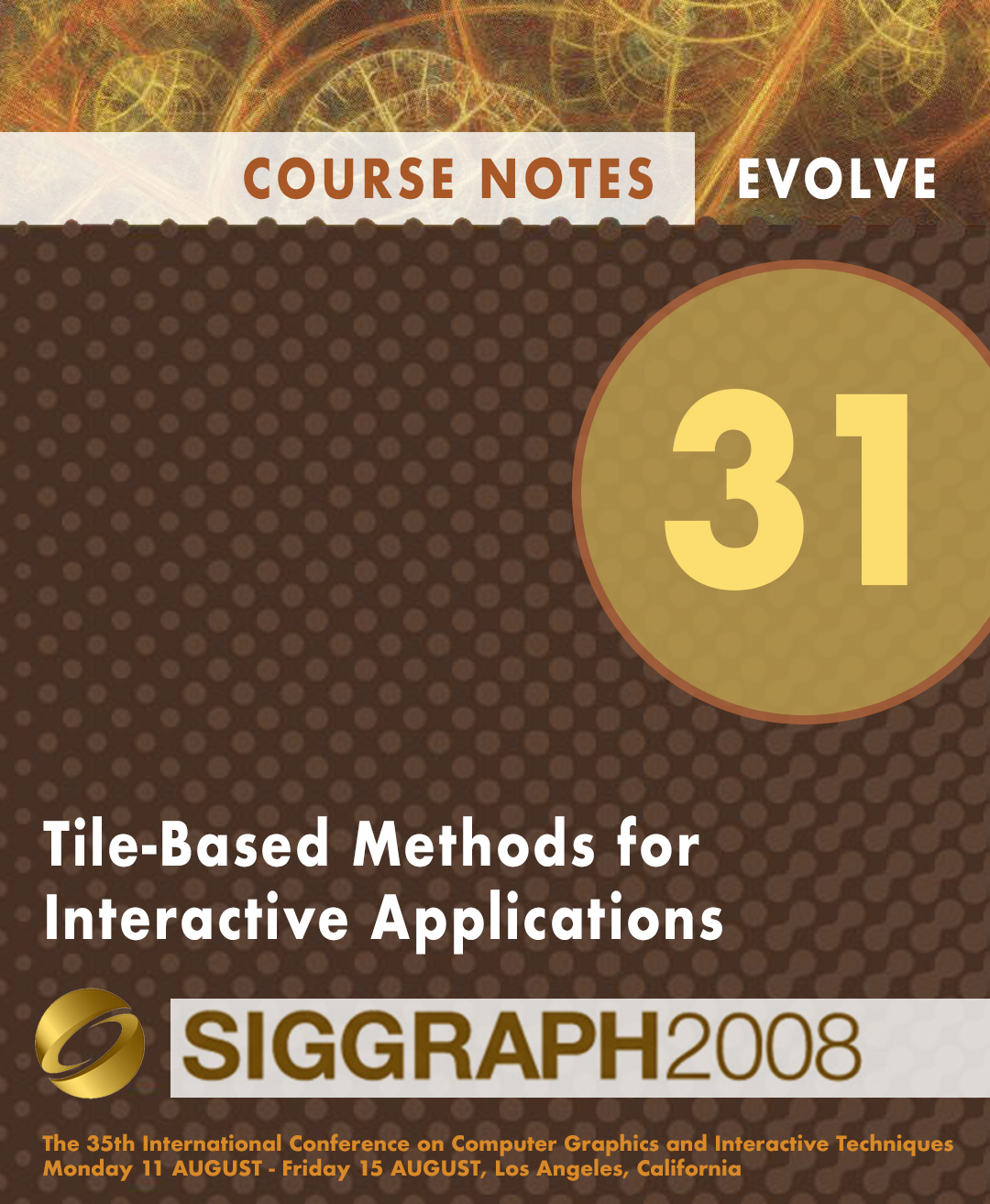“Tile-Based Methods for Interactive Applications” by Lagae, Kaplan, Fu, Ostromoukhov and Deussen
Conference:
Type(s):
Entry Number: 31
Title:
- Tile-Based Methods for Interactive Applications
Course Organizer(s):
Presenter(s)/Author(s):
Abstract:
Prerequisites & Who Should Attend
The intended audience for this class is both the experienced graphics researcher, interested in applying tile-based methods to his own research, and the graphics practitioner, interested in using the tile-based methods covered in this class.
Description
Over the last years, several techniques have been demonstrated that rely on tile-based methods. A lot of interactive applications could potentially benefit from these techniques. However, the state-of-the-art is scattered over several publications, and survey works are not available. In this class we give a detailed overview of tile-based methods in computer graphics. The class consists of four parts, which are briefly covered in the following paragraphs.
Tile-Based Methods using Wang and Corner Tiles: The first part of the class intro- duces tile-based methods in computer graphics based on Wang tiles and corner tiles. This part serves as a general introduction for the class, but also covers methods and applications based on Wang tiles and corner tiles. We introduce Wang tiles and corner tiles, and present several tiling algorithms. We discuss in detail tile-based texture mapping using graphics hardware, tile-based generation of Poisson disk distributions, and object distribution for procedural texturing. We briefly cover other applications such as sampling, non-photorealistic rendering, and geometric object distribution. The lecturer for the first part is Ares Lagae, who recently finished his PhD about tile-based methods in computer graphics [Lagae, 2007].
Periodic Tilings for Computer Graphics Applications: The second part of the class introduces the mathematical and algorithmic aspects of decorative tilings such as those used by M. C. Escher. It focuses on the theory of isohedral tilings, tilings that cover the plane systematically with congruent copies of a single shape. The isohedral tilings are flexible enough to support a wide variety of applications in art and design, while admitting a compact and efficient implementation. We show how to store, manipulate and render isohedral tilings, and survey some recent applications. The lecturer for the second part is Craig Kaplan, an expert on the use of computer graphics in ornamental design Kaplan [2002].
Tile-Based Methods for Surface Modeling: The third part of the class covers tile- based methods for surface modeling. Tiling is a practical and cost-effective method for high-quality surface modeling and rendering. Rather than intensive data acquisition and synthesis, the generalized Wang tile set presented in this part of the talk allows us to seamlessly and non-periodically tile texture data on parameterized surfaces of arbitrary topology. Once we synthesize textures on tiles, we can reuse the same tile set on different surfaces and we can also instantaneously change the surface appearance by just switching the reference tile set. Further than color textures, we also extend surface tiling to include bump maps, geometry details, the BTF’s, as well as Poisson disk tiling. The lecturer for the third part is Chi-Wing Fu, who wrote several papers on this topic [Fu and Leung, 2005].
Non-Periodic Tilings for Computer Graphics Applications: The fourth part of the class covers an important class of non-periodic tilings and their benefits for computer graphics applications. First, the theory of Penrose tilings is presented. We show how the inherent self-similarity of Penrose tiling can be exploited in order to get efficient implementation of uniform distributions with blue-noise properties. Then, we present polyomino-based uniform distributions, and show their advantages. Finally, we explore other non-periodic tiling systems, potentially usable for computer graphics applications: dodecagonal tiling, Ammann tiling, etc. The lecturer for the fourth part is Victor Ostromoukhov who is an expert in this topic [Ostromoukhov et al., 2004; Ostromoukhov, 2007].
Tile-Based Methods for Non-Photorealistic Rendering and Landscape Modeling: The fifth part of the class covers applications of tile-based methods in the fields of non-photorealistic rendering and landscape modeling [Cohen et al., 2003]. Using hierarchical tile sets one is able to create point sets with infinite density still showing Poisson disk characteristics [Kopf et al., 2006]. We will demonstrate this using a set of tiles that is recursively subdivided. This is possible because the set shows self similarity. The resulting points can be used to create stipple drawings and also distributions of plants that also show Poisson disk behavior. This will be demonstrated by an application that enables real-time modeling and rendering of complex landscapes. The lecturer for the fifth part is Oliver Deussen, who has considerable experience with tile-based design.




